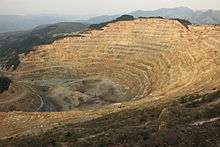Roșia Poieni copper mine
 | |
| Location | |
|---|---|
 Roșia Poieni mine Location in Romania | |
| Location | Roşia Montană |
| Commune | Alba County |
| Country | Romania |
| Coordinates | 46°18′53″N 23°10′17″E / 46.31472°N 23.17139°ECoordinates: 46°18′53″N 23°10′17″E / 46.31472°N 23.17139°E |
| Production | |
| Products | Copper |
| Production | 11,000 tonnes |
| Financial year | 2008 |
| History | |
| Opened | 1929 |
| Owner | |
| Company | CupruMin |
The Roșia Poieni copper mine is a large open pit copper mine in the centre of Romania, 90 km northwest of Alba Iulia and 484 km north of the capital, Bucharest. Geographically the mine is located in the Apuseni Mountains, 7 kilometres (4.3 mi) south of the Arieş River in Lupșa commune. The access to the site is made through a south-west industrial haul road from Cornii Valley that crosses the National Road no. 74 Alba-Iulia – Zlatna – Abrud when entering Abrud and through a north industrial haul road from Musca Valley that crosses the National Road no. 75 Campeni – Turda in Musca village, Lupșa commune.[1]
The Rosia Poieni deposit was developed between the sixth and eight decade of the 20th century within the Abrud-Musca-Bucium area (the Golden Quadrilateral) from Apuseni Mountains of the Metaliferi Mountains. The mine produces around 11,000 tonnes of copper a year and the mineral deposit represents 65% of the total copper reserves in Romania. The mine is owned by CupruMin a state owned company.[1]
Geology
Roșia Poieni represents the largest copper reserve in Romania and the second largest in Europe having estimated reserves of 1.5 billion tonnes of ore grading 0.36% copper.[1] It is enclosed by eruptive sub-volcanoes Miocene rocks (micro-diorite or Fundoaia andesites).[1]
The Fundoaia body has the shape of a vertical column of 1,180 metres (3,870 ft) in height (+1,030 metres (3,380 ft) → −150 metres (−490 ft)) and in horizontal plane having the following dimensions: 660 metres (2,170 ft)÷740 metres (2,430 ft)/820 metres (2,690 ft)÷956 metres (3,136 ft).[1] The eruptive body comes in contact (through the tectonic breccia) with andesite necks (Poieni, Curmatura, Melciu, Piatra Tichileu, and Jgheabului Hills) and with sedimentary Cretaceous rocks.[1] The porphyry copper deposit is made up mainly of fine disseminations, nests and veinlets (0.02÷3 cm) of pyrite, chalcopyrite, and magnetite; gold included in the chalcopyrite and pyrite, and secondary minerals: bornite, covellite, chalcocite, sphalerite, galena, molybdenite, germanite, malachite, azurite and is developed in microdioritic rocks.[1]
Ore processing
The ore extracted from the open pit is crushed in a gyratory crusher after being transported and stored in the crushed ore storage facility located within the processing plant site. The processing plant has a design capacity of 9 millions tones extracted and processed per year, the process being made on 4 technological lines of 7,500 tones per day.[1] The plant was launched between 1985 and 1987. The ore is subsequently processed through a classical processing flow, with a two-stage grinding phase in two autogenous mills and in two ball mills, followed by flotation, which is performed in pneumomechanical cells (17 square metres (180 sq ft)) where the primary concentrate is obtained, which subsequently is flotated in cells of 5.7 square metres (61 sq ft) where a copper concentrate is obtained with a content between 16.5 and 20% copper. The concentrate is thickened in sided thickeners and filtered through a pressure filter (Larox).[1]